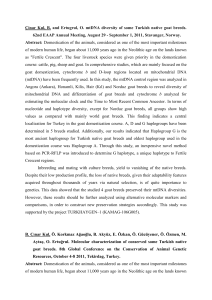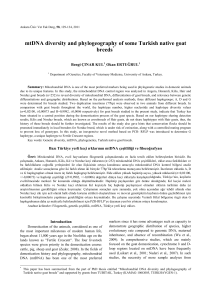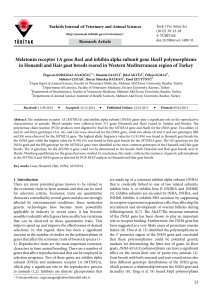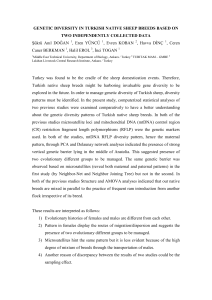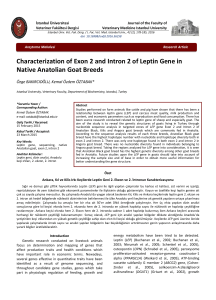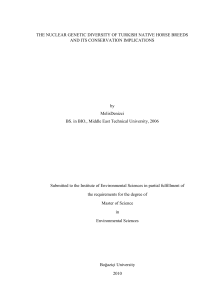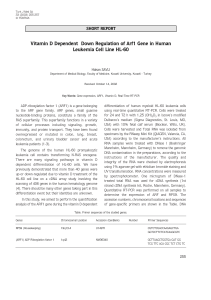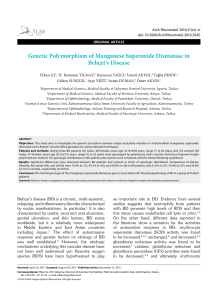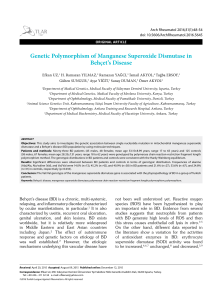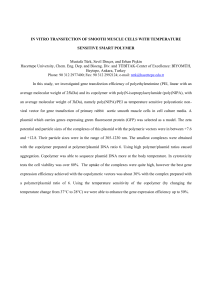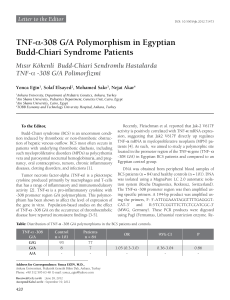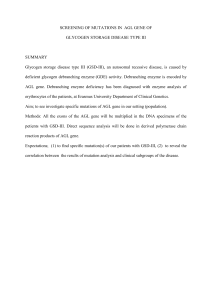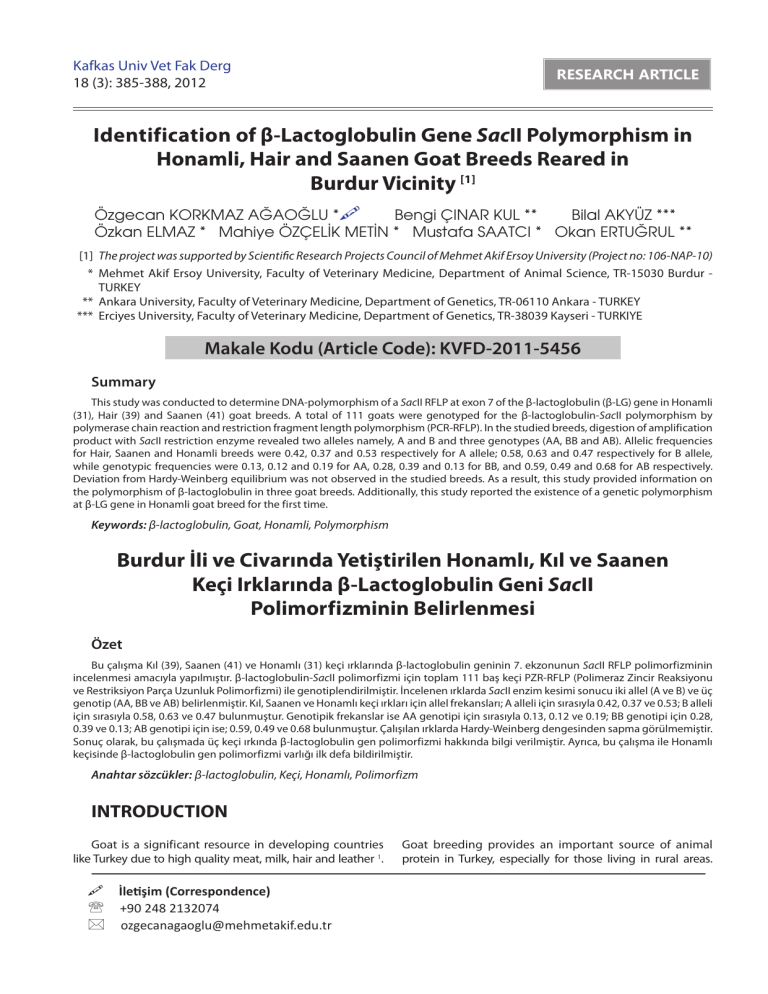
Kafkas Univ Vet Fak Derg
18 (3): 385-388, 2012
RESEARCH ARTICLE
Identification of β-Lactoglobulin Gene SacII Polymorphism in
Honamli, Hair and Saanen Goat Breeds Reared in
Burdur Vicinity [1]
Özgecan KORKMAZ AĞAOĞLU *
Bengi ÇINAR KUL **
Bilal AKYÜZ ***
Özkan ELMAZ * Mahiye ÖZÇELİK METİN * Mustafa SAATCI * Okan ERTUĞRUL **
[1] The project was supported by Scientific Research Projects Council of Mehmet Akif Ersoy University (Project no: 106-NAP-10)
* Mehmet Akif Ersoy University, Faculty of Veterinary Medicine, Department of Animal Science, TR-15030 Burdur TURKEY
** Ankara University, Faculty of Veterinary Medicine, Department of Genetics, TR-06110 Ankara - TURKEY
*** Erciyes University, Faculty of Veterinary Medicine, Department of Genetics, TR-38039 Kayseri - TURKIYE
Makale Kodu (Article Code): KVFD-2011-5456
Summary
This study was conducted to determine DNA-polymorphism of a SacII RFLP at exon 7 of the β-lactoglobulin (β-LG) gene in Honamli
(31), Hair (39) and Saanen (41) goat breeds. A total of 111 goats were genotyped for the β-lactoglobulin-SacII polymorphism by
polymerase chain reaction and restriction fragment length polymorphism (PCR-RFLP). In the studied breeds, digestion of amplification
product with SacII restriction enzyme revealed two alleles namely, A and B and three genotypes (AA, BB and AB). Allelic frequencies
for Hair, Saanen and Honamli breeds were 0.42, 0.37 and 0.53 respectively for A allele; 0.58, 0.63 and 0.47 respectively for B allele,
while genotypic frequencies were 0.13, 0.12 and 0.19 for AA, 0.28, 0.39 and 0.13 for BB, and 0.59, 0.49 and 0.68 for AB respectively.
Deviation from Hardy-Weinberg equilibrium was not observed in the studied breeds. As a result, this study provided information on
the polymorphism of β-lactoglobulin in three goat breeds. Additionally, this study reported the existence of a genetic polymorphism
at β-LG gene in Honamli goat breed for the first time.
Keywords: β-lactoglobulin, Goat, Honamli, Polymorphism
Burdur İli ve Civarında Yetiştirilen Honamlı, Kıl ve Saanen
Keçi Irklarında β-Lactoglobulin Geni SacII
Polimorfizminin Belirlenmesi
Özet
Bu çalışma Kıl (39), Saanen (41) ve Honamlı (31) keçi ırklarında β-lactoglobulin geninin 7. ekzonunun SacII RFLP polimorfizminin
incelenmesi amacıyla yapılmıştır. β-lactoglobulin-SacII polimorfizmi için toplam 111 baş keçi PZR-RFLP (Polimeraz Zincir Reaksiyonu
ve Restriksiyon Parça Uzunluk Polimorfizmi) ile genotiplendirilmiştir. İncelenen ırklarda SacII enzim kesimi sonucu iki allel (A ve B) ve üç
genotip (AA, BB ve AB) belirlenmiştir. Kıl, Saanen ve Honamlı keçi ırkları için allel frekansları; A alleli için sırasıyla 0.42, 0.37 ve 0.53; B alleli
için sırasıyla 0.58, 0.63 ve 0.47 bulunmuştur. Genotipik frekanslar ise AA genotipi için sırasıyla 0.13, 0.12 ve 0.19; BB genotipi için 0.28,
0.39 ve 0.13; AB genotipi için ise; 0.59, 0.49 ve 0.68 bulunmuştur. Çalışılan ırklarda Hardy-Weinberg dengesinden sapma görülmemiştir.
Sonuç olarak, bu çalışmada üç keçi ırkında β-lactoglobulin gen polimorfizmi hakkında bilgi verilmiştir. Ayrıca, bu çalışma ile Honamlı
keçisinde β-lactoglobulin gen polimorfizmi varlığı ilk defa bildirilmiştir.
Anahtar sözcükler: β-lactoglobulin, Keçi, Honamlı, Polimorfizm
INTRODUCTION
Goat is a significant resource in developing countries
like Turkey due to high quality meat, milk, hair and leather 1.
İletişim (Correspondence)
+90 248 2132074
ozgecanagaoglu@mehmetakif.edu.tr
Goat breeding provides an important source of animal
protein in Turkey, especially for those living in rural areas.
386
Identification of β-Lactoglobulin ...
Several goat breeds such as the Angora, Kilis, Honamli,
Hair, Norduz, Saanen are reared in different regions of the
Turkey. Hair goat, also known as black goat, is a major goat
breed of the Turkey. This goat breed is a multipurpose
animal in terms of meat, milk and hair 2. Saanen goat is a
breed of Switzerland and known worldwide for high milk
yield 2. Honamli goat breed is widespread throughout the
slopes of Taurus Mountains, provinces of Burdur, Antalya,
Isparta and Konya for both milk and meat yields 3.
Polymorphisms in milk protein genes are used as
markers for milk yield. Milk protein polymorphisms have
been studied intensively because of their effect on the yield
and processing properties of milk and its products. Betalactoglobulin (β-LG) is one of the two major whey proteins
identified in the milk of animals including cattle, sheep,
goat, dogs, and pigs. On the other hand, this protein is not
identified in human, mice, lagomorphs and other some
mammalian species 4. Genetic polymorphisms identified
in β-LG gene lead to the formation of its different variants
within and between various species 5. The relationship
between genetic variants of the β-LG and milk composition,
milk yield and cheese-making ability has been reported
in cow (Shiwal and Tharparkar cattle 6 and Najdi cattle 7),
goat (Indian goats) 4 and sheep (Manchega sheep 8 and
Massese ewes 9). β-LG was the first milk protein in which
polymorphism was identified by protein electrophoresis of
bovine milk 10. Then, genetic polymorphisms in β-LG have
been described both at protein level 11-13 and DNA level 14-16
in farm animals. The electrophoretic pattern of the β-LG
gene in domestic goats has been analyzed for the first time
by SDS-PAGE 4. Additionally, two genetic variants (A and B)
of β-LG were reported in goat milk 17 at protein level. Then,
β-LG gene polymorphism has been analyzed by PCRRFLP 4. Polymorphisms in both exon 7 and the proximal
promoter region of β-LG gene in Spanish and French
goats were investigated, and two novel genetic variants
were reported 18,19. β-LG polymorphism was reported in
different goat populations at protein 20-22 and DNA 23,24 level
in Turkey. However, no information has been reported for
especially Honamli goats regarding β-LG polimorphisms
at the DNA level.
The aim of the present paper was to investigate genetic
polymorphism of a SacII RFLP at Exon 7 of the β-LG gene in
Hair, Honamli and Saanen goat breeds by PCR-RFLP.
MATERIAL and METHODS
Samples and DNA isolation
A total of 111 blood samples were collected from three
different goat breeds around Burdur region in their natural
habitats. The animal material included 39 Hair goats, 41
Saanen goats and 31 Honamli goats. Blood samples from
the goats were placed into an EDTA tubes for DNA isolation.
Genomic DNA was isolated using Genomic DNA Isolation
kit (Qiagen QIAamp DNA Blood Mini Kit) following the
manufacturer’s protocol. The quality of DNA was checked
on 0.8% agarose gels and stained with ethidium bromide.
DNA Amplification and Genotyping
Genotyping for β-LG-SacII polymorphism was performed
by Polymerase Chain Reaction-Restriction Fragment Length
Polymorphism (PCR-RFLP) as proposed by Pena et al.18.
The sequences of the forward and reverse primers for the
amplification of the β-lactoglobulin gene (accession number
Z33881.1) were: forward 5’-CGG GAG CCT TGG CCC TCT
GG-3’; reverse 5’-CCT TTG TCG AGT TTG GGT GT-3’. PCR for
the β-lactoglobulin gene was performed in a 25 µl reaction
mixture, containing 1.5 mM MgCl2, 200 µM of each dNTPs,
200 µM of each primer, 1 X PCR buffer, 1U Taq polymerase
and 100 ng of genomic DNA template. The reaction mixture
was placed in a DNA Amplitronyx 6 thermal cycler. Thermal
cycling conditions included: an initial denaturation step
at 95°C for 5 min followed by 35 cycles of 95°C for 30 s,
65°C for 60 s, 72°C for 60 s and a final extension at 72°C
for 5 min. The PCR products were digested with 10 U of
SacII restriction endonuclease (Fermentas) at 37°C for at
least 3 h. PCR products and restriction fragments were
electrophoresed on 2% and 3% agarose gels respectively
and stained with ethidium bromide.
Statistical Analysis
Direct counting was used to estimate genotype and
allele frequencies of β-LG gene SacII genetic variants.
Chi-square statistic (χ2) was used to check whether the
populations were Hardy-Weinberg equilibrium. All statistical
analyses were performed using PopGene32 software 25.
RESULT
The β-LG gene (exon 7 to the 3’flanking region) of Hair,
Honamli and Saanen goat was investigated by PCR-RFLP
method. A fragment of 426 bp was successfully amplified
(Fig. 1) and digested with SacII restriction enzymes to
detect the presence of A or B variants. PCR-RFLP with the
SacII enzyme revealed the polymorphic site, which was
produced by a single nucleotide substitution in position
+4601 18. As a result of amplification product with SacII
digestion, two alleles, A and B, were observed. Restriction
digestion of 426bp PCR products with SacII enzymes
revealed three genotypes (Fig. 2) of AA (426 bp), BB (349
and 77 bp) and AB (426, 349 and 77 bp). The allelic and
genotypic frequencies of the β-LG gene polymorphism for
the Hair, Saanen and Honamli goats were given in Table 1.
The results of Chi-square statistic reflected that breeds
were in Hardy-Weinberg equilibrium.
Allelic frequencies for Hair, Saanen and Honamli breeds
were determined as 0.42, 0.37 and 0.53 respectively for A
allele; 0.58, 0.63 and 0.47 respectively for B allele, whereas
genotypic frequencies were 0.13, 0.12 and 0.19 for AA,
387
KORKMAZ AĞAOĞLU, ÇINAR KUL, AKYÜZ, ELMAZ
ÖZÇELİK METİN, SAATCI, ERTUĞRUL
Fig 1. PCR amplifications of β-LG gene (426bp, lanes 1-2). Lane
M, molecular size marker (100 bp DNA ladder)
Sekil 1. β-LG geninin PZR ürünleri (426bp, hat 1-2). Hat M,
moleküler büyüklük belirteci (100 bç DNA ladder)
Fig 2. Electrophoresis of RFLP of caprine β-LG gene after
digestion by SacII of animals with AA (Lane 2,5; 426bp), AB
(Lane 4,6; 426bp/349bp/77bp, BB (Lane 1,3; 349bp/77bp)
genotypes. Lane M, molecular size marker (100 bp DNA ladder)
Sekil 2. Keçi β-LG geninin SacII enzim kesim ürünlerinin
agaroz jeldeki fotografı. Hat 2,5 AA (426bç); Hat 4,6 AB
(426bç/349bç/77bç); Hat 1,3 BB (349bç/77bç) genotipleri. Hat
M, molekülür büyüklük belirteçi (100 bç DNA merdiveni)
Table 1. Allele and genotype frequencies of β-LG gene for SacII site in Hair, Saanen and Honamli goat breeds
Tablo 1. Kıl, Saanen ve Honamli keçi ırklarında β-LG geninin SacII bölgesinin allel ve genotip frekansları
Genotype
Breed
n
AA
Allele Frequency
AB
BB
Obs (Exp)
F.
Obs (Exp)
F.
Obs (Exp)
F.
A
B
χ2 (df=1)
p-value
Hair
39
5 (6.857)
0.13
23 (19.286)
0.59
11 (12.857)
0.28
0.423
0.577
1.487
0.223 NS
Saanen
41
5 (5.370)
0.12
20 (19.259)
0.49
16 (16.370)
0.39
0.366
0.634
0.062
0.803 NS
Honamli
31
6 (8.656)
0.19
21 (15.689)
0.68
4 (6.656)
0.13
0.532
0.468
3.673
0.055 NS
111
16 (20.634)
0.14
64 (54.733)
0.58
31 (35.634)
0.28
0.432
0.568
3.212
0.073 NS
All breeds
F: Frequency; : Non significant
NS
0.28, 0.39 and 0.13 for BB, and 0.59, 0.49 and 0.68 for AB
respectively. A significant deviation from Hardy-Weinberg
equilibrium was not observed in the investigated breeds.
DISCUSSION
In the present study, genetic polymorphism of the β-LG
gene in Hair, Honamli and Saanen goat breeds were
investigated. The 426 bp product of exon 7 to the 3’ flanking
region of the β-LG gene was digested with restriction
endonucleas SacII in three goat breeds. For SacII site two
alleles (A and B) were found and three genotypes (AA, AB
and BB) were detected.
Regarding polymorphism of β-LG locus eight variants
have been reported at the DNA level at the bovine β-LG
locus, however, alleles A and B are the most frequent 26 and
allele B was associated with a lower whey protein content
and a higher casein content in milk 26. In sheep, three
variants (A, B and C) have been reported 27. Polymorphisms
in both exon 7 and the proximal promoter region of β-LG
gene in Spanish and French goats were investigated, and
two novel genetic variants were reported 18,19. Two genetic
variants (A and B) of β-LG were reported in goat milk at
protein 17 and DNA 4,18,19 level. The presence of β-LGA and
β-LGB at this locus was reported in Alpine and Saanen goats 28
and in Jamunapari, Sirohi, Barbari and Jakhrana breeds 11.
Similar results were observed in all studied breeds.
Similarly, three genotypes were observed in Hair, Saanen
and Honamli goats at the β-LG locus. AB genotype was the
most frequent genotype in the entire studied sample.
Goat β-LG polymorphism has been investigated with
233 Hair goat breeds by Elmaci et al.24 They revealed that
the frequency of AA (S2S2, 0.11) genotype was found to
be lower than BB (S1S1, 0.45) and AB (S1S2, 0.44) genotypes and then the genotypic frequencies of BB and AB
genotypes were very close. Additionally Elmaci et al.24
showed that the frequency of S2 (A) allele at β-LG locus was
lower compared to the frequency of S1 (B) allele. This was
consistent with the result of the present study in exception
with Honamli goat. Previously, polymorphism studies about
β-LG locus for Barki, Damascus and their cross breeds 14
showed lower frequencies of B allele in comparison with
the present study (all breeds). Kumar et al.4 reported the
frequency of S2S2 (BB) genotype with a large range of 0.42
to 1.00 in the population and S2 (B) allele frequency higher
than S1 (A) allele frequency 4. This was consistent with Hair
and Saanen goat breeds, but not Honamli goat. Garg et
al.12 reported the presence of two genetic variants at
β-lactoglobulin locus (A and B) and the gene frequencies
of β-LGA and β-LGB were 0.910 and 0.090, respectively. This
388
Identification of β-Lactoglobulin ...
was consistent with Honamli goat, but not Hair and Saanen
goat breeds. Kumar et al.11 and Boulanger 28 were studied
this locus and indicated that variant A was dominant over
variant B, which is corroborated with Garg et al.12 findings.
But this was consistent with the result of the present study
in exception with Honamli goat.
In the present study, it was reported that Hair, Honamli
and Saanen goat breeds from Burdur have genetic polymorphism in β-LG gene. Especially, this study showed
the existence of a genetic polymorphism at β-LG gene
in Honamli goats for the first time. Further evaluation
is required to confirm the correlation with milk yield. In
addition, it is very crucial to investigate further goat breeds
for determining the polymorphism at proximal promoter
region of β-LG gene and other genes to generate results of
the present study. Finally data showed that PCR-RFLP is an
appropriate tool for investigating genetic polymorphism.
Also, the results of β-LG gene polymorphism can be reliably
used in genetic characterization of Turkish native goat
breeds, determination of biodiversity and evolution in
world goat breeds.
Acknowledgements
The authors would like to thank to Associate Professor
Hilal ÖZDAĞ, who kindly checked the English grammar of
the manuscript.
REFERENCE
1. Akçapınar H: Keçi Yetiştiriciliği Ders Notu. Ankara Üniv. Vet. Fak.
Zootekni Anabilim Dalı, 1994.
2. Porter V: Goats of the World. Farming Press, Ipswich, UK, 1996.
3. Soysal Mİ: Honamli Goat (2007). http://www.turkhaygen.gov.tr/doc/
honamli_sunu.pdf. Accessed: 04.07.2010.
4. Kumar A, Rout PK, Roy R: Polymorphism of β -lacto globulin gene in
Indian goats and its effect on milk yield. J Appl Genet, 47 (1): 49-53, 2006.
5. Patel RK, Chauhan JB, Singh KM, Soni KJ: Allelic frequency of kappacasein and beta-lactoglobulin in Indian crossbred (Bos taurus × Bos
indicus) dairy bulls. Turk J Vet Anim Sci, 31 (6): 399-402, 2007.
6. Rachagani S, Gupta ID, Gupta N, Gupta SC: Genotyping of
β-lactoglobulin gene by PCR-RFLP in Sahiwal and Tharparkar cattle
breeds. BMC Genetics, 7, 31 doi:10.1186/1471-2156-7-31, 2006.
7. Karimi K, Beigi Nassiri MT, Mirzadeh KH, Ashayerizadeh A,
Roushanfekr H, Fayyazi J: Polymorphism of the β-lactoglobulin gene
and its association with milk production traits in Iranian Najdi cattle. Int J
Biotechnol, 7 (2): 82-85, 2009.
8. Garzon AI, Martinez J: β-Lactoglobulin in Manchenga sheep bred:
relationship with milk technological indexes in handcraft manufacture of
Manchengo cheese. Anim Genet, 23 (Suppl. 1): 106, 1992.
9. Melea M, Conte G, Serra A, Buccion A, Secchiari P: Relationship
between beta-lactoglobulin polymorphism and milk fatty acid composition
in milk of Massese dairy ewes. Small Rumin Res, 73, 37-44, 2007.
10. Aschaffenburg R, Drewry J: Occurrence of different β-lactoglobulins
in cow’s milk. Nature, 176, 218-219, 1955.
11. Kumar P, Rout PK, Shukla SN, Mandal A, Roy R: Genetics of milk
protein variants in different Indian goats. Xth International Congress AsianAustralian Association of Animal Production Societies (AAAP), Sept. 22-24,
New Delhi: 168, 2002.
12. Garg N, Singh SK, Rout PK, Mandal A: Genetic Polymorphism of
Milk Proteins in Barbari Goats. Trop Subtrop Agroecosyst, 11, 181-183, 2009.
13. Baranyi M, Kerekes A, Hiripi L, Bősze Z: Preliminary data on betalactoglobulin genetic polymorphisms in Hungarian Awassi and Racka
sheep. Anim Sci Biotechnol, 43 (1): 1-4, 2010.
14. El-Hanafy AA, El-Saadani MA, Eissa M, Maharem GM, Khalifa ZA:
Polymorphism of β-lactoglobulin gene in Barki and Damascus and their
cross bred goats in relation to milk yield. Biotechnol Anim Husbandry, 26
(1-2): 1-12, 2010.
15. Elyasi G, Shodja J, Nassiry MR, Tahmasebi A, Pirahary O,
Javanmard A: Polymorphism of β-lactoglobulin gene in Iranian sheep
breeds using PCR-RFLP. J Molecular Genetics, 2 (1): 6-9, 2010.
16. Öner Y, Pullu M, Akın O, Elmacı C: Bursa bölgesinde yetiştirilen
İsviçre Esmeri ve Siyah Alaca ırkı sığırlarda beta laktoglobulin (β-lg)
ve büyüme hormonu (bGH) gen polimorfizmlerinin HaeIII ve MspI
restriksiyon enzimleri kullanilarak incelenmesi. Kafkas Univ Vet Fak Derg
17 (3): 371-376, 2011.
17. Moili B, Pilla F, Tripaldi C: Detection of milk protein genetic
polymorphism in order to improve dairy traits in sheep and goats: A
review. Small Rumin Res, 27, 185-195, 1998.
18.Pena RN, Sanchez A, Folch JM: Characterization of genetic
polymorphism in the goat beta-lactoglobulin gene. J Dairy Res, 67, 217224, 2000.
19. Yahyaoui MH, Pena RN, Sanchez A, Folch JM: Rapid communication:
polymorphism in the goat beta-lactoglobulin proximal promoter region.
J Anim Sci, 78, 1100-1101, 2000.
20. Ozdil F, Asal S: The Polymorphism of β-Lactoglobulin. Proceedings of
the 3rd Annual Meeting on Animal Science September, 14-16, Ankara, Turkey,
2002.
21. Turkyilmaz O: The milk protein polymorphism in Saanen goats with
high milk yielding. PhD Thesis. Uludag Univ. Institute of Health Sci, Bursa,
Turkey, 2003.
22. Gurcan N: The polymorphism of B- lactoglobulin in some Angora and
Hair goat populations. MSc Thesis. Ankara University, Graduate School of
Natural and Applied Science, Ankara, Turkey, 2005.
23. Elmaci C, Oner Y, Koyuncu M: Saanen keçilerinde β-laktoglobulin
genotiplerinin PCR-RFLP yöntemi ile belirlenmesi. Hayvansal Üretim, 49
(1): 1-4, 2008.
24.Elmaci C, Oner Y, Koyuncu M: Allelic frequencies of a SacII RFLP
at exon 7 of the β-lactoglobulin gene in Turkish hair goat breed. Asian J
Anim Vet Adv, 4 (3): 130-133, 2009.
25. Yeh F, Yang RC, Boyle T: Popgene (v.1.32), Microsoft Windows-based
freeware for Population Genetic Analysis, 2000. http:// www.ualberta.
ca/~fyeh/Pop32.exe. Accessed: 20.08.2011
26. Ng-Kwai-Hang KF: Genetic polymorphism of milk proteins:
Relationships with production traits, milk composition and technological
properties. Can J Anim Sci, 78, 131-147, 1998.
27. Erhardt G: Evidence for a third allele at the beta-lactoglobulin (betaLg) locus of sheep milk and its occurrence in different breeds. Anim Genet,
20, 197-204, 1989.
28. Boulanger A: Etude Biochimique et Genetique des Proteins du Lait
de Chevre (Capra hircus). Thesis, University of Paris VII, 1976.

